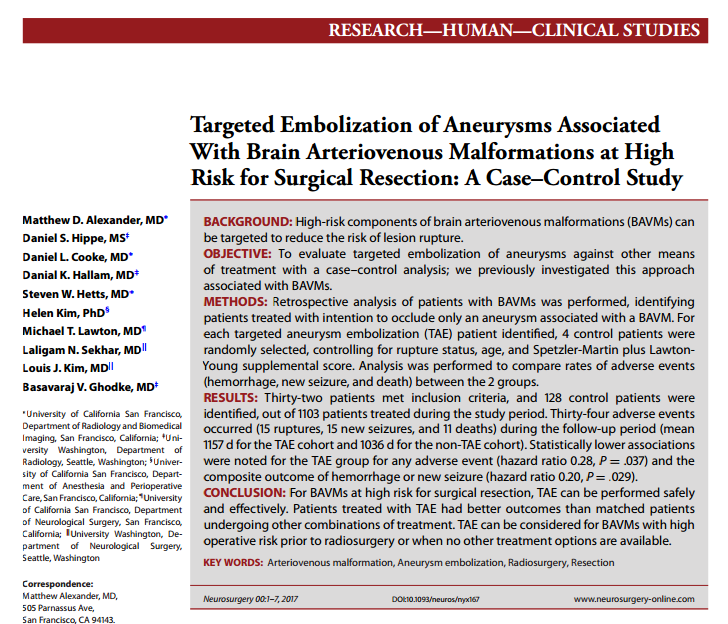高危脑动静脉畸形动脉瘤的栓塞治疗:病例对照研究(0Targeted Embolization of Aneurysms Associated With Brain Arteriovenous Malformations at High Risk for Surgical Resection: A Case–Control Study)
英文简介:
BACKGROUND: High-risk components of brain arteriovenous malformations (BAVMs) can be targeted to reduce the risk of lesion rupture.
OBJECTIVE: To evaluate targeted embolization of aneurysms against other means of treatment with a case–control analysis; we previously investigated this approach associated with BAVMs.
METHODS: Retrospective analysis of patients with BAVMs was performed, identifying patients treated with intention to occlude only an aneurysm associated with a BAVM. For each targeted aneurysm embolization (TAE) patient identified, 4 control patients were randomly selected, controlling for rupture status, age, and Spetzler-Martin plus LawtonYoung supplemental score. Analysis was performed to compare rates of adverse events (hemorrhage, new seizure, and death) between the 2 groups.
RESULTS: Thirty-two patients met inclusion criteria, and 128 control patients were identified, out of 1103 patients treated during the study period. Thirty-four adverse events occurred (15 ruptures, 15 new seizures, and 11 deaths) during the follow-up period (mean 1157 d for the TAE cohort and 1036 d for the non-TAE cohort). Statistically lower associations were noted for the TAE group for any adverse event (hazard ratio 0.28, P = .037) and the composite outcome of hemorrhage or new seizure (hazard ratio 0.20, P = .029).
CONCLUSION: For BAVMs at high risk for surgical resection, TAE can be performed safely and effectively. Patients treated with TAE had better outcomes than matched patients undergoing other combinations of treatment. TAE can be considered for BAVMs with high operative risk prior to radiosurgery or when no other treatment options are available.
中文简介:
背景:脑动静脉畸形(BAVMs)的高危部位可作为降低病变破裂风险的靶点。
目的:通过病例对照分析,评价动脉瘤的靶向栓塞与其他治疗方法的优劣;我们之前研究了与BAVMs相关的这种方法。
方法:回顾性分析与BAVM相关的患者,确定仅打算闭塞与BAVM相关的动脉瘤的患者。对于每个确定的靶向动脉瘤栓塞(TAE)患者,随机选择4例对照患者,控制破裂状态、年龄和Spetzler-Martin + LawtonYoung补充评分。分析比较两组不良事件发生率(出血、新发癫痫、死亡)。
结果:在研究期间接受治疗的1103例患者中,32例符合纳入标准,128例为对照组患者。随访期间发生34例不良事件(15例破裂,15例新发癫痫,11例死亡)(TAE组平均1157 d,非TAE组平均1036 d)。TAE组的不良事件发生率(危险比0.28,P = .037)和出血或新发癫痫的复合结局(危险比0.20,P = .029)均低于对照组。
结论:对于高危手术切除的BAVMs, TAE是顺利合适的。接受TAE治疗的患者比接受其他联合治疗的患者有更好的结果。在放射外科手术前或在没有其他治疗选择的情况下,TAE可考虑用于手术风险高的BAVMs。

颅内出血(ICH)是脑动静脉畸形(BAVMs)较危险的表现,也是这些病变患者预后不佳的主要原因。BAVM治疗试图通过完全切除或清除病灶来预防出血。如果预期的风险超过了治疗的风险,就应该考虑治疗。根据病变的特点,一种或多种治疗方式可能是较合适的。可以提供栓塞、放射治疗、切除或这些治疗的联合。显微外科手术提供了即时和持久的结果,消除了ICH的风险,如果完全切除实现。然而,如果没有的发病率,一些BAVMs是不能切除的。在这种病变中,可以选择性地治疗相关动脉瘤等高危特征,以降低出血的风险。在较近发表的大型队列研究中,36%的BAVMs患者发现了动脉瘤。我们的小组之前评估了未进行后续切除的与BAVMs相关的动脉瘤的靶向栓塞治疗。本研究采用病例对照分析的方法,比较动脉瘤靶向栓塞(TAE)与其他治疗方式的疗效。
BAVM治疗旨在消除或减少ICH的风险。治疗是很有挑战性的,确定一个病灶的更佳治疗是需要考虑的。TAE治疗与BAVMs相关的动脉瘤既顺利又合适,因为对于BAVMs,手术切除是危险的。对于这样的高危病变,应该考虑TAE。
INC国际神经外科医生集团旗下组织国际神经外科顾问团(WANG)成员Michael T. Lawton 教授作为主要研究者之一,是当今国际上享有盛誉的脑血管病教授,他专注各脑血管病、脑动脉瘤、动静脉畸形、海绵状畸形、血管搭桥、中风、颅底肿瘤的手术治疗,对于较大而复杂的脑动脉瘤手术尤为精通。此外,他还提供中枢、外周和自主神经系统疾病的手术和非手术治疗(即预防、诊断、评估、治疗、重症监护和康复),包括其支持结构和血管供应;评估和治疗改变神经系统功能或活动的病理过程。对于脑紊乱、颅外颈动脉、椎动脉、脑垂体紊乱、脊髓/脑膜和脊柱疾病(包括可能需要通过脊柱融合或器械治疗的疾病)等有丰富经验。目前拥有4400余例脑动脉瘤、800余例动静脉畸形和1000余例海绵状畸形患者的成功治疗经验。
论文来源:https://sci-hub.se/https://www.ncbi.nlm.nih.gov/pubmed/28419337




